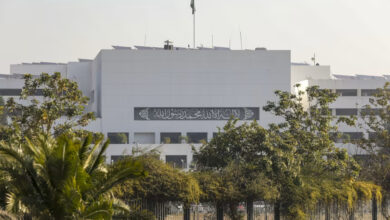
The killing of five Egyptian jihadis in North Sinai, allegedly by an Israeli drone, raises questions about the number of militants in the region, particularly after the 30 June protests and the overthrow of President Mohamed Morsy.
Events escalated before 30 June when Mohamed al-Zawahry, the brother of Al Qaeda leader Ayman al-Zawahry, visited Arish in North Sinai. This piece of information was disclosed by jihadi leader Morgan Salem, when asked why Zawahry had disappeared. It later became clear that the National Security Agency had interrogated Mohamed al-Zawahry before releasing him.
Zawahry's call to his followers, to wait for a defining moment in their struggle, appeared to confirm links between the Al Qaeda leader's brother and events in Sinai.
Zawahry seems to have believed that unrest and instability following 30 June would allow him to announce Sinai as an Islamic emirate.
He was confronted by security forces.
Nabil Naeem, one of the Jihad Organization's founders, told Egypt Independent that the number of jihadis in Egypt amounts to around 2,000 and some of them have ideological and organizational links to Al Qaeda.
The majority of jihadis are believed to reside in areas close to the Egypt-Israel border, spurred on by the spread of jihadi ideas and weak security control near the demilitarized, desert area.
Brotherhood-jihadi links
There appear to be links between the Muslim Brotherhood and jihadis, something made apparent by two events. The first, when Morsy released a number of militants via presidential pardon. The second, when Brotherhood leaders threatened the army with jihadi fighters.
The overthrow of Morsy was followed by military confrontations with jihadis in Sinai, which alleges to possible Brotherhood links to armed elements, beside the remarks of Brotherhood leader Mohamed al-Beltagy, who linked continued clashes in Sinai with the return of Morsy to power when talking on the stage at Rabaa al-Adaweya Square sit-n.
Enemy of my enemy is my friend
Although most jihadi groups in Sinai believe that the Muslim Brotherhood are infidels, viewed as a damaging influence on the wider Islamic project, they are willing to defend them against more secular elements in society. These same groups took advantage of events on the streets in the hope of establishing an Islamic emirate. They believe the Brotherhood let them down by failing to establish an Islamic state in Egypt.
Is suspected coordination between Egyptian and Israeli armed forces an attempt to eliminate jihadi elements in Sinai? What is happening on the peninsula confirms coordination at the highest level, particularly because armed groups represent a threat to Israel. They are therefore a common enemy for both states.
An Egyptian military source told Egypt Independent on condition of anonymity that confronting jihadis is a common interest between Egypt and Israel in light of the Camp David Accords which prevents Egyptian warplanes from flying in the border region.
The source says that the security coordination between both parties allowed the use of heavy weapons in the area and warplanes on Gaza Strip to monitor jihadis, which is against the Camp David agreement.
The source has not denied that five Egyptian Jihadists were killed in Rafah by Israeli drones, saying they were about to launch rockets on Israel.
Ahmed Mohamed Ali, the Egyptian military spokesperson, meanwhile denied the incident. The Israeli army did not comment so as not to embarass its Egyptian counterpart.
Israeli army spokeswoman and the IDF refused to comment when approached by Reuters, AP and Egypt Independent.
In a follow-up statement on Saturday Ali explained that the mission was carried out by Egyptian helicopters targeting armed militants who were preparing to direct rockets at Egypt.
Categorizing jihadi organizations
Radical Salafi currents dominate the Sinai region due to the neglect of Al-Azhar in the remote area which lies far from Cairo. As a result, radical groups spread due to an absence of moderate preachers in the area.
Sufism dominated the Sinai region for decades before being affected by the jihadi trend when Sayyed Qotb fled there before being executed by the Egyptian authorities, activist Abdel Qader Suweilam explained to Egypt Independent.
"The spread of jihadi forces in Sinai, especially al-Takfir w al-Hijra, feeds off the lack of moderate Islam in the region, creating a hospot for jihadis in Sinai," he added.
Suweilam belonged to al-Takfir w al-Hijra and was one of the acquitted defendants in the 2006 Taba bombing.
Jihad leader Abdel Hamid Sobh, who lives in the Asdood area on the Egypt-Israel border and was detained for more than 20 years for smuggling weapons to resistance movements in Palestine, says there are many jihadi elements in Sinai – including al-Tawhid w al-Jihad, Ansar al-Jihad and others.
According to Sobh, Al-Tawhid w al-Jihad group was called al-Takfir w al-Jihad before its members changed the name due to the negative connotations of "Takfir" (accusing someone of being an infidel).
Jihadi ideas are usually preceded by infidelity accusations (takfir) and followed by bombing operations. Such ideas spread quickly like wildfire, Sobh said.




